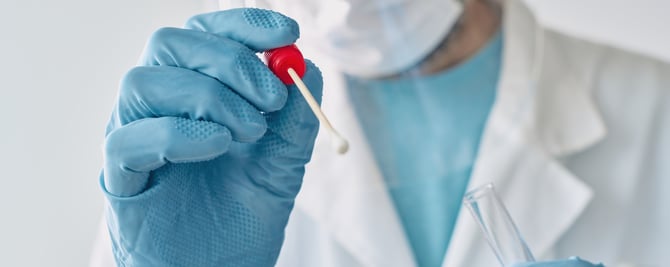Contact us for more information!
Webinar Q&A
1. What are the conjugation ratio methods based on?
Dr. Mikael Jumppanen: There are different approaches. One is direct methods, like MALDI-TOF mass spectrometry, where you directly measure the conjugation ratio of the protein. The other ones are indirect methods, where instead of measuring the conjugation directly, you label the free conjugation sites that are left unbound after the reaction — for example with TNBSA (for lysine conjugations) or Ellman’s assay (for cysteine). That gives you an indirect estimate of the ratio.
Ella-Maria Vesilahti: So basically, direct gives you a precise readout of the conjugation itself, while indirect gives you more flexibility in terms of format and throughput.
2. Which one is better — MALDI-TOF or TNBSA? Pros and cons?
Dr. Mikael Jumppanen: MALDI-TOF is very powerful because it’s a direct measurement — you know exactly what the ratio is, and it works for multiple different conjugation chemistries. But it’s not always the most scalable tool, especially for routine or high-throughput use. Indirect methods like TNBSA, on the other hand, can be done in a 96-well plate format, which makes them easy to scale up and cost effective. It works only with lysine conjugates.
Dr. Laura Kolsi: So in practice, it’s less about which one is “better” overall, and more about which tool is the right fit for your needs. For a detailed, precise measurement, MALDI-TOF is excellent. For screening or when working with many samples, TNBSA is very practical.
Ella-Maria Vesilahti: It’s more about using different tools as needed — you pick the method that matches the scale, the project goals, and the type of protein you’re working with.
3. Do you determine the conjugation ratio at Medix Biochemica?
Dr. Mikael Jumppanen: Yes, we do. Depending on the project, we apply different methods, but what really matters is that the conjugations are reproducible. Conjugation ratio is one of the parameters we are interested in, because it helps us understand consistency across batches. All in all, reproducibility is the key outcome we focus on.
Ella-Maria Vesilahti: Reproducibility is really what ensures customers can trust the product, no matter the exact ratio. Without that, even the best ratio wouldn’t have much value.
4. What should we keep in mind if the conjugation ratio is increased?
Dr. Mikael Jumppanen: When you raise the conjugation ratio, you really need to optimize the conditions of the reaction. For example, the concentration of the reagents (DMF, protein concentration) can have a big impact on the outcome.
Dr. Laura Kolsi: Yes, it’s important to be cautious. If you push the ratio too high, you may run into protein precipitation, which obviously affects the function of the conjugate.
Ella-Maria Vesilahti: So there’s a trade-off — higher ratio might sound better, but at some point you risk losing activity, and that can actually reduce the performance of the assay.
5. Can you give an example of a customization project?
Dr. Laura Kolsi: Sure. A typical customization project has been when a customer asks us to adjust the conjugation ratio of one of our catalogue products. In some cases, they’ve wanted a lower ratio to improve solubility, and in others a higher ratio to get for example stronger signal or then both to evaluate which one gives the best possible performance.
Ella-Maria Vesilahti: That’s a great example of how “catalog” doesn’t have to mean “one-size-fits-all.” Even with standard products, there’s room to tailor them to the specific needs of the customer.
6. Which one is more important, specificity or affinity?
Ella-Maria Vesilahti: The importance of specificity and affinity depends on the platform and assay type used. With Drug-of-Abuse analytes competitive assay set-ups are commonly used, and there can be a lot of similar analytes to interfere in the assay. In competitive assays the specificity of the assay is heavily leaning to the single antibody used, so it needs to have the right specificity. Nevertheless, the affinity of the antibody must be suitable for the assay type. For example, in lateral flow, antibody usually needs to have fast on-rate to be able to bind the analyte fast enough. In the other hand, in some assays, like EMIT, the antibody also needs to have decent off-rate to allow the competition between analyte and conjugate.
7. How kinetics data can be used for assay development?
Ella-Maria Vesilahti: For most products from Medix Biochemica, the kinetic constants can be seen in the product specification sheets. When choosing a suitable antibody, you can compare and evaluate the association and dissociation rates to select the best antibody for your assay type.
8. I have an issue in my lateral flow application gives false negatives what could be the issue?
Ella-Maria Vesilahti: There are several different things that might cause false negatives. Generally, there can be some technical reasons: too much or not enough reagents, matrix effect, the conjugation procedure may inactive the antibody or the flow in the membrane is not optimal. These are just some examples. If the question is related to some of our products, you can contact our product support for more information.
9. Do I need permissions to purchase DoA conjugates?
Dr. Mikael Jumppanen: That is a great question. You don’t, because they are not regulated, because they have this linker attached to them, and then they are communicated to some protein, so they are not active compounds anymore.
10. How big quantities you are able to produce DoA conjugates?
Dr. Laura Kolsi: Our processes are well scalable and we can go up to around 10 g.
11. Can we get a recording of the webinar?
Dr. Voutilainen: Yes, we always provide a recording after each session. You can expect to receive the link in an email within two business days after each webinar, and here’s the link for: Building Effective Drugs of Abuse Assays: Conjugates, Kinetics, and Customization. Feel free to watch it at your convenience and share it with your team. To stay informed about upcoming topics and events, we recommend subscribing to our event updates. That way, you’ll never miss a session that’s relevant to you.















